T3-U Module Datasheet
Last Updated on : 2025-08-18 03:02:06download
T3-U module is a Wi-Fi 6 and Bluetooth Low Energy (LE) combo module developed by Tuya Smart. It is composed of a highly integrated radio-frequency identification (RFID) chip T3 and a few peripheral components. It can run in the station (STA) mode and access point (AP) mode.
Overview
T3-U has a built-in 32-bit MCU with a maximum running speed of 320 MHz, built-in 4 MB flash memory, and 640 KB SRAM. The module supports cloud connectivity, and the MCU’s extended instructions for signal processing enable it to efficiently implement audio encoding and decoding. Various peripherals are available, such as PWM, UART, and SPI. Up to five channels of 32-bit PWM output make the chip ideal for high-quality LED control.
Features
- Built-in low-power 32-bit CPU that also acts as an application processor.
- Clock rate of 320 MHz.
- Operating voltage range: 2.0V to 3.6V.
- Peripherals: 5 PWM pins, 3 UARTs, and 1 SPI.
- Wi-Fi connectivity
- IEEE 802.11b/g/n/ax.
- Channels 1 to 14 at 2.4 GHz.
- Support WEP, WPA/WPA2, WPA/WPA2 PSK (AES), and WPA3 security modes.
- The average output power is +18 dBm for IEEE 802.11b transmission.
- Support STA, AP, STA + AP combo, and direct working modes.
- Two pairing modes are supported, Bluetooth and Wi-Fi access point (AP) mode. Both modes are suitable for pairing with Android and iOS mobile phones.
- The onboard PCB antenna has a peak gain of -1.04 dBi.
- Operating temperature range: -40°C to 105°C.
- Bluetooth connectivity
- Bluetooth Core Specification v5.4.
- The transmitter power in Bluetooth mode is 7 dBm.
- Integral Wi-Fi and Bluetooth coexistence interface.
- The onboard PCB antenna has a peak gain of -1.04 dBi.
Scope of applications
- Smart building
- Smart home and electrical appliance
- Smart socket and light
- Industrial wireless control
- Baby monitor
- IP camera
- Smart bus
Module interfaces
Dimensions and footprint
The T3-U dimensions are 15.8±0.35 mm (W) × 20.3±0.35 mm (L) × 2.5±0.15 mm (H). The following figure shows the dimensions and packaging design of the T3-U module.
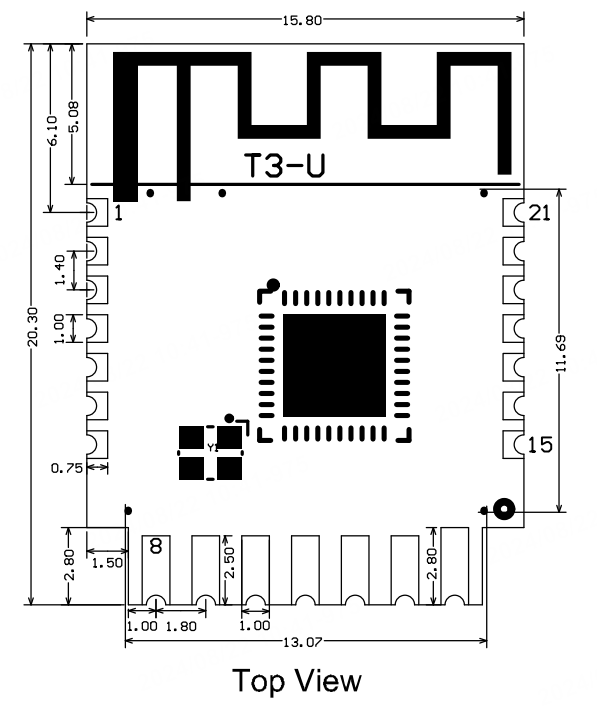
Pin definition
| Pin No. | Symbol | I/O type | Description |
|---|---|---|---|
| 1 | P14 | I/O | A normal GPIO pin, corresponding to Pin 33 on the IC. It can be reused as SPI_SCK. |
| 2 | P16 | I/O | A normal GPIO pin, corresponding to Pin 35 on the IC. It can be reused as SPI_MOSI. |
| 3 | RX2 | I/O | UART_RX2, corresponding to P40 (Pin 40) on the IC. |
| 4 | TX2 | I/O | UART_TX2, corresponding to P41 (Pin 39) on the IC. |
| 5 | ADC | I/O | An ADC pin, corresponding to P25 (Pin 12) on the IC. |
| 6 | RX1 | I/O | UART_RX1, corresponding to P1 (Pin 17) on the IC. |
| 7 | TX1 | I/O | UART_TX1 to print logs, corresponding to P0 (Pin 18) on the IC. |
| 8 | P24 | I/O | Support hardware PWM, corresponding to Pin 11 on the IC. |
| 9 | P32 | I/O | Support hardware PWM, corresponding to Pin 14 on the IC. |
| 10 | P34 | I/O | Support hardware PWM, corresponding to Pin 15 on the IC. |
| 11 | P36 | I/O | Support hardware PWM, corresponding to Pin 16 on the IC. |
| 12 | P18 | I/O | Support hardware PWM, corresponding to Pin 37 on the IC. |
| 13 | GND | P | Ground pin. |
| 14 | 3V3 | P | 3.3V power pin. |
| 15 | TX0 | I/O | UART_TX0 to send user data, corresponding to P11 (Pin 19) on the IC. |
| 16 | RX0 | I/O | UART_RX0 to receive user data, corresponding to P10 (Pin 20) on the IC. |
| 17 | P12 | I/O | A normal GPIO pin, corresponding to Pin 21 on the IC. |
| 18 | CEN | I/O | The reset pin, active low, and pulled up internally. Corresponding to Pin 26 on the IC. |
| 19 | P13 | I/O | A normal GPIO pin, corresponding to Pin 22 on the IC. |
| 20 | P17 | I/O | A normal GPIO pin, corresponding to Pin 36 on the IC. It can be reused as SPI_MISO. |
| 21 | P15 | I/O | A normal GPIO pin, corresponding to Pin 34 on the IC. It can be reused as SPI_CS. |
- The maximum input level of the ADC port is 3.25 V. It is recommended to place a 100 nF ground filter capacitor close to the ADC port.
Pindicates the power pin, andI/Oindicates the input and output pin.- For the MCU integration solution, please refer to Tuya’s design document T3-X Series Modules.
Electrical parameters
Absolute electrical parameters
| Parameter | Description | Minimum value | Maximum value | Unit |
|---|---|---|---|---|
| Ts | Storage temperature | -55 | 125 | °C |
| VBAT | Supply voltage | -0.3 | 3.9 | V |
| Electrostatic discharge voltage (human body model) | TAMB -25°C | -4 | 4 | kV |
| Electrostatic discharge voltage (machine model) | TAMB -25°C | -200 | 200 | V |
Normal operating conditions
| Parameter | Description | Minimum value | Typical value | Maximum value | Unit |
|---|---|---|---|---|---|
| Ta | Operating temperature | -40 | - | 105 | °C |
| VBAT | Supply voltage | 2.0 | 3.3 | 3.6 | V |
| VOL | I/O low-level output | VSS | - | VSS + 0.3 | V |
| VOH | I/O high-level output | VBAT − 0.3 | - | VBAT | V |
| Imax | I/O drive current | - | 6 | 20 | mA |
Radio frequency (RF) power
| Operating status | Mode | Rate | Transmit/Receive power | Average value | Peak (Typical) value | Unit |
|---|---|---|---|---|---|---|
| Transmit | 802.11b | 11 Mbit/s | +18 dBm | 230 | 241 | mA |
| Transmit | 802.11g | 54 Mbit/s | +16 dBm | 200 | 210 | mA |
| Transmit | 802.11n | HT20 MCS7 | +15 dBm | 170 | 186 | mA |
| Transmit | 802.11ax | HE20 MCS7 | +15 dBm | 160 | 170 | mA |
| Receive | 802.11b | 11 Mbit/s | Continuous reception | 14 | 15 | mA |
| Receive | 802.11g | 54 Mbit/s | Continuous reception | 14 | 15 | mA |
| Receive | 802.11n | HT20 MCS7 | Continuous reception | 14 | 15 | mA |
| Receive | 802.11ax | HE20 MCS7 | Continuous reception | 14 | 15 | mA |
Operating current
| Operating mode | Status (Ta = 25°C) | Average value | Max (Typical) value | Unit |
|---|---|---|---|---|
| Quick pairing (Bluetooth) | The module is pairing over Bluetooth. The network status indicator blinks slowly. | 75 | 360 | mA |
| Quick pairing (AP) | The module is in AP mode. The network status indicator blinks slowly. | 105 | 370 | mA |
| Connected | The module is connected to the cloud. The network status indicator is steady on. | 45 | 300 | mA |
| Weakly connected | The connection between the module and the hotspot is intermittent. The network status indicator is steady on. | 135 | 360 | mA |
| Disconnected | The module is disconnected from the cloud. The network status indicator is steady off. | 47 | 320 | mA |
| Module disabled | The module’s clock enable (CEN) pin is pulled down. | 330 | - | μA |
- Low power long standby current: Typical value 150 µA @ DTIM10.
- The above data module is powered by a 3.3 V regulated power supply with firmware v6.0.6. There are slight differences in test data under different test environment conditions.
RF parameters
Basic RF features
| Parameter | Description |
|---|---|
| Operating frequency | 2.412 to 2.484 GHz |
| Wi-Fi standard | IEEE 802.11b/g/n/ax (channels 1–14) |
| Data transmission rate |
|
| Antenna type | PCB antenna |
Wi-Fi transmitter (TX) performance
| Parameter | Minimum value | Typical value | Maximum value | Unit |
|---|---|---|---|---|
| RF average output power, 802.11b CCK Mode, 11 Mbps | 16 | 18 | 20 | dBm |
| RF average output power, 802.11g OFDM Mode, 54 Mbps | 14 | 16 | 18 | dBm |
| RF average output power, 802.11n OFDM Mode, HT20 MCS7 | 13 | 15 | 17 | dBm |
| RF average output power, 802.11n OFDM Mode, HT40 MCS7 | 12 | 14 | 16 | dBm |
| RF average output power, 802.11ax OFDMA Mode, HE20 MCS7 | 13 | 15 | 17 | dBm |
| RF Average output power, 802.11ax OFDMA Mode, HE40 MCS7 | 12 | 14 | 16 | dBm |
| Frequency error | -20 | - | 20 | ppm |
Wi-Fi receiver (RX) performance
| Parameter | Minimum value | Typical value | Maximum value | Unit |
|---|---|---|---|---|
| PER < 8%, RX sensitivity, 802.11b DSSS mode, 11 Mbit/s | - | -89 | - | dBm |
| PER < 10%, RX sensitivity, 802.11g OFDM mode, 54 Mbit/s | - | -76 | - | dBm |
| PER < 10%, RX sensitivity, 802.11n OFDM mode, MCS7 (HT20) | - | -74 | - | dBm |
| PER < 10%, RX sensitivity, Bluetooth, 1 Mbit/s | - | -96 | - | dBm |
Bluetooth transmitter (TX) performance
| Parameter | Minimum value | Typical value | Maximum value | Unit |
|---|---|---|---|---|
| Operating frequency | 2402 | - | 2480 | MHz |
| Transmission rate over the air | - | 1 | - | Mbit/s |
| Transmission power | -20 | 7 | 20 | dBm |
| Frequency error | -150 | - | 150 | KHz |
Bluetooth receiver (RX) performance
| Parameter | Minimum value | Typical value | Maximum value | Unit |
|---|---|---|---|---|
| RX sensitivity | - | -96 | - | dBm |
| Max RF signal input | -10 | - | - | dBm |
| Intermodulation | - | - | -23 | dBm |
| Adjacent-channel rejection ratio | - | 10 | - | dB |
Antenna information
Antenna type
The T3-U module uses an onboard PCB antenna.
Antenna interference reduction
When a PCB antenna is used on a Wi-Fi module, we recommend that the module antenna is at least 15 mm away from other metal components. This can optimize the Wi-Fi performance.
Make sure that the enclosure surrounding the antenna is not traced or filled with copper. Otherwise, the RF performance might be degraded.
Packing and production instructions
Mechanical dimensions
Dimensions of the T3-U PCB are 15.8±0.35 mm (W) × 20.3±0.35 mm (L) × 1.0±0.1 mm (H).
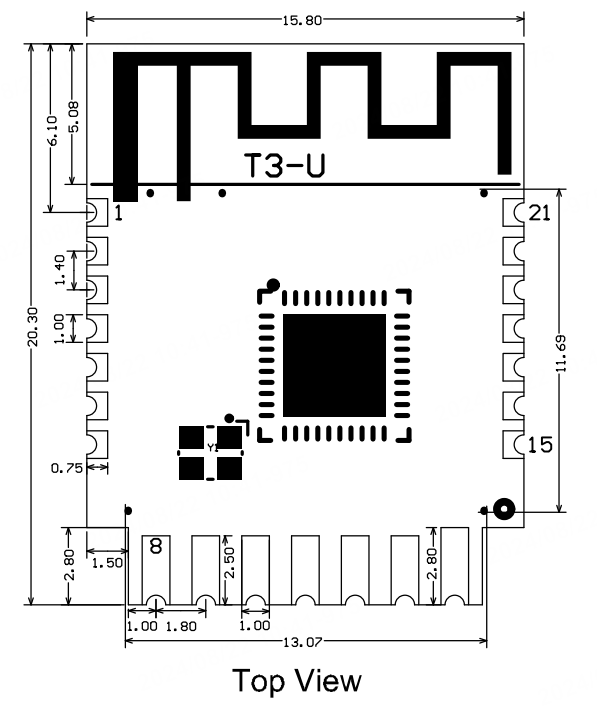
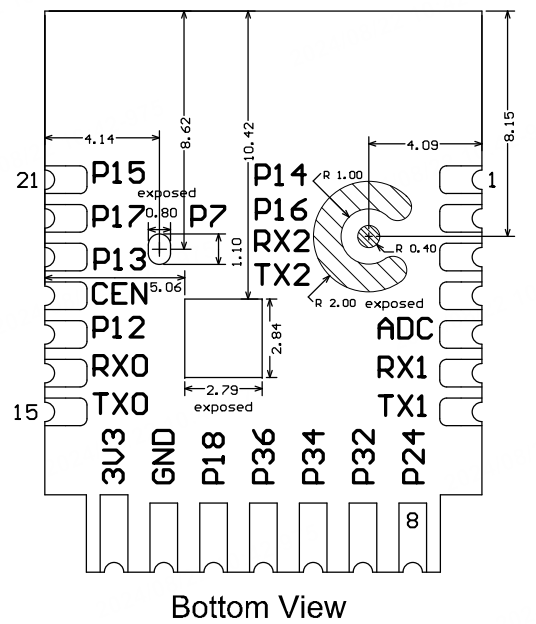
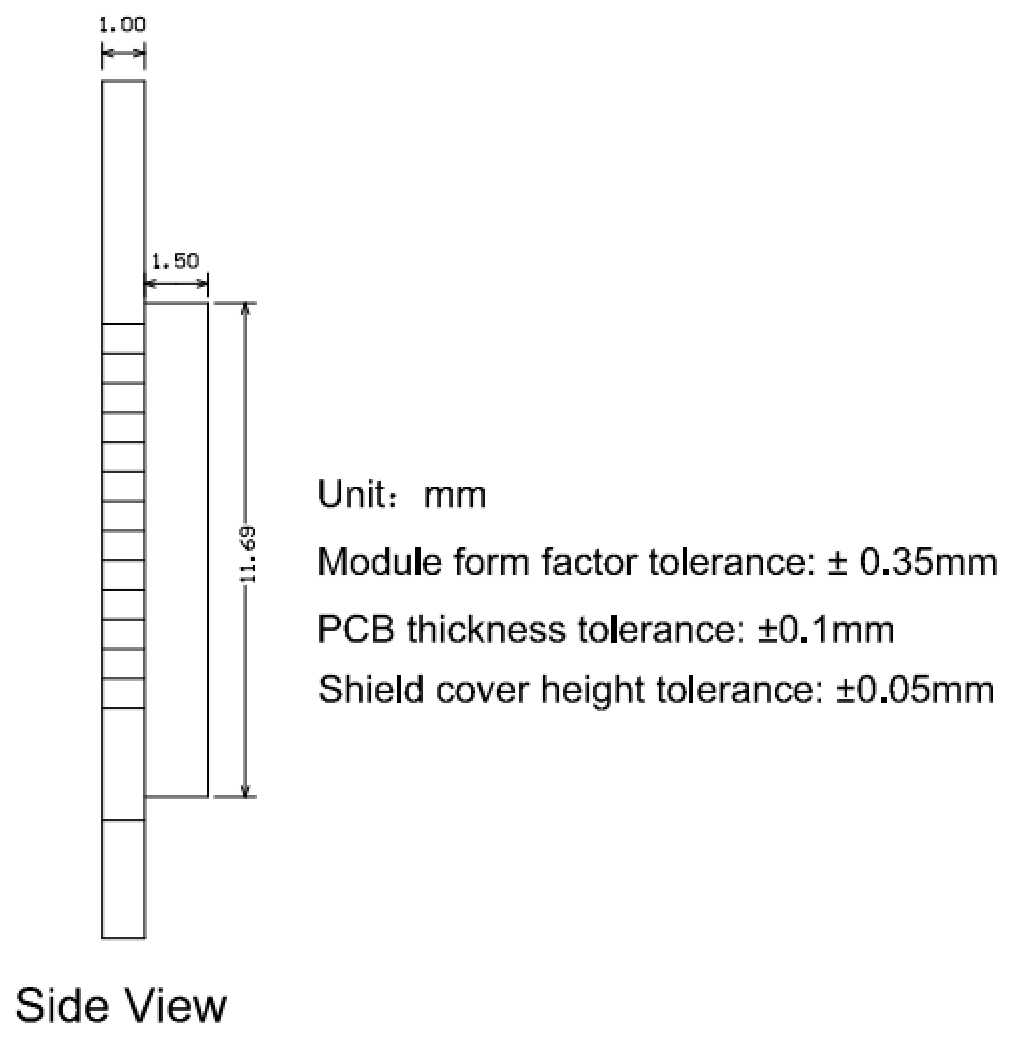
The following figure shows the recommended footprint of the T3-U module.
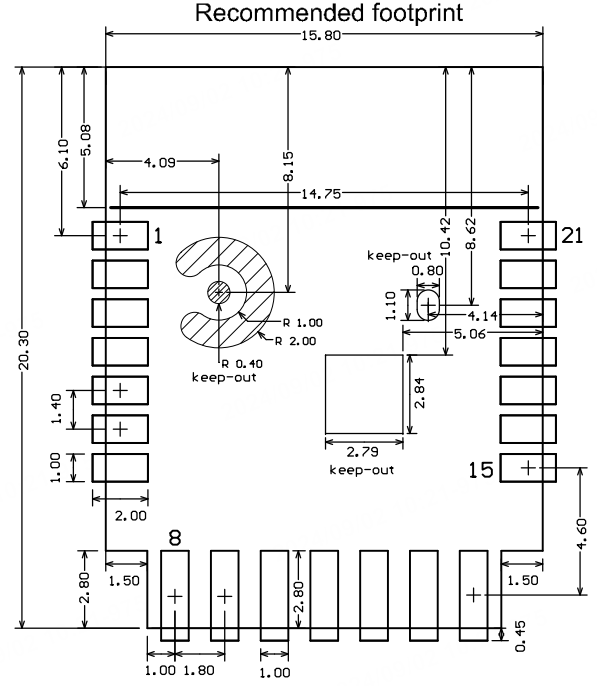
The area indicated as keep-out in the diagram above does not require tinning and should not have any traces routed through it.
Production instructions
-
For the modules that can be packaged with the surface-mount technology (SMT) or in in-line form, you can select either of them according to the PCB design solutions of customers. If a PCB is designed to be SMT-packaged, package the module with the SMT. If a PCB is designed to use an in-line package, use wave soldering. Complete soldering within 24 hours after the module is unpacked. Otherwise, we recommend that you place the module in a drying cupboard with a relative humidity level below 10%, or pack the module in vacuum again. Then, record the packing time and duration of exposure. The total exposure time cannot exceed 168 hours.
- Instruments or devices required for the SMT process:
- Surface mount system
- SPI
- Reflow soldering machine
- Thermal profiler
- AOI
- Instruments or devices required for the wave soldering process:
- Wave soldering equipment
- Wave soldering fixture
- Constant-temperature soldering iron
- Tin bar, tin wire, and flux
- Thermal profiler
- Instruments or devices required for the baking process:
- Cabinet oven
- Electro-static discharge (ESD) protection and heat-resistant trays
- ESD protection and heat-resistant gloves
- Instruments or devices required for the SMT process:
-
A delivered module must meet the following storage requirements:
-
The moisture-proof bag must be placed in an environment where the temperature is below 40°C and the relative humidity is lower than 90%.
-
The shelf life of a dry-packaged product is 12 months from the date when the product is packaged and sealed.
-
A humidity indicator card (HIC) is put in the sealed package.
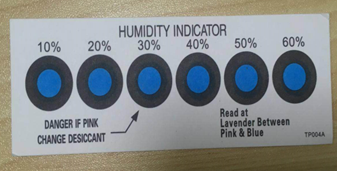
-
-
The module needs to be baked in the following cases:
- The vacuum packaging bag is damaged before unpacking.
- After unpacking, no HIC is found in the packaging bag.
- After unpacking, the HIC indicates a humidity level of 10% or higher. In this case, the circle turns pink on the HIC.
- The total exposure time has lasted for over 168 hours since unpacking.
- More than 12 months have passed since the first sealing of the bag.
-
The baking parameter settings are described below:
- Baking temperature: 40°C for reel packaging with relative humidity ≤ 5%. And 125°C for tray packaging with relative humidity ≤ 5% (use the heat-resistant tray, rather than plastic containers).
- Baking time: 168 hours for reel packaging and 12 hours for tray packaging.
- Temperature for triggering an alert: 50°C for reel packaging and 135°C for tray packaging.
- Production can begin after a module has cooled down to below 36°C under natural conditions.
- If a module remains unused for over 168 hours after being baked, it needs to be baked again.
- If a batch of modules is not baked after exposure for more than 168 hours, do not use reflow soldering or wave soldering to solder them. Because these modules are level-3 moisture-sensitive devices, they are very likely to get damp when exposed beyond the allowable time. In this case, if they are soldered at high temperatures, device failure or poor soldering performance might occur.
-
In the whole production process, take electrostatic discharge (ESD) protective measures.
-
To guarantee the pass rate, we recommend that you use the SPI and AOI to monitor the quality of solder paste printing and mounting.
Recommended oven temperature curve
Select a proper soldering technique according to the process. For more information, refer to the recommended oven temperature curve of either reflow soldering or wave soldering. The set temperatures might deviate from the actual temperature measurements. All temperatures shown in this module datasheet are obtained through actual measurements.
Technique 1: SMT process (recommended oven temperature curve of reflow soldering)
Set the oven temperatures according to the following curve.
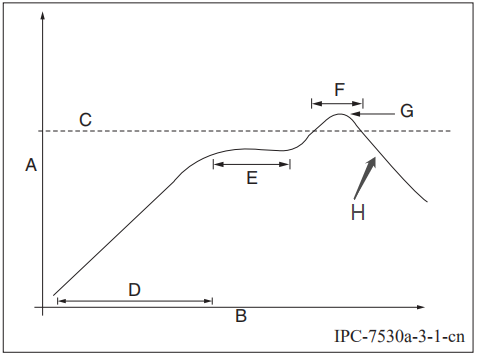
-
A: temperature axis
-
B: time axis
-
C: alloy liquidus temperature from 217°C to 220°C
-
D: ramp-up slope from 1°C/s to 3°C/s
-
E: keep a constant temperature from 150°C to 200°C for a time period of 60s to 120s
-
F: temperature above liquidus temperature for 50s to 70s
-
G: peak temperature from 235°C to 245°C
-
H: ramp-down slope from 1°C/s to 4°C/s
The curve above is based on solder paste SAC305. For more information about other solder pastes, see the recommended oven temperature curve in the specified solder paste specifications.
Technique 2: Wave soldering process (oven temperature curve of wave soldering)
Set the oven temperatures according to the following temperature curve of wave soldering. The peak temperature is 260°C±5°C.
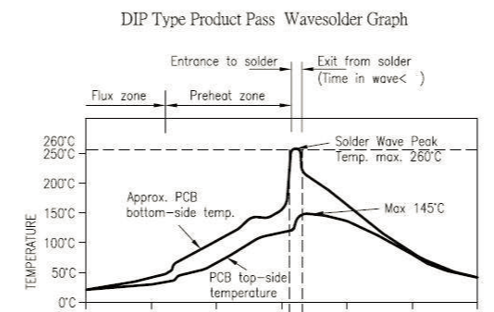
| Suggestions on wave soldering | Suggestions on manual repair soldering | ||
|---|---|---|---|
| Preheat temperature | 80°C to 130°C | Soldering temperature | 360°C ± 20°C |
| Preheat duration | 75s to 100s | Soldering duration | Less than 3s/point |
| Contact duration at the peak | 3s to 5s | N/A | N/A |
| Solder tank temperature | 260°C ± 5°C | N/A | N/A |
| Ramp-up slope | ≤ 2°C/s | N/A | N/A |
| Ramp-down slope | ≤ 6°C/s | N/A | N/A |
Storage conditions
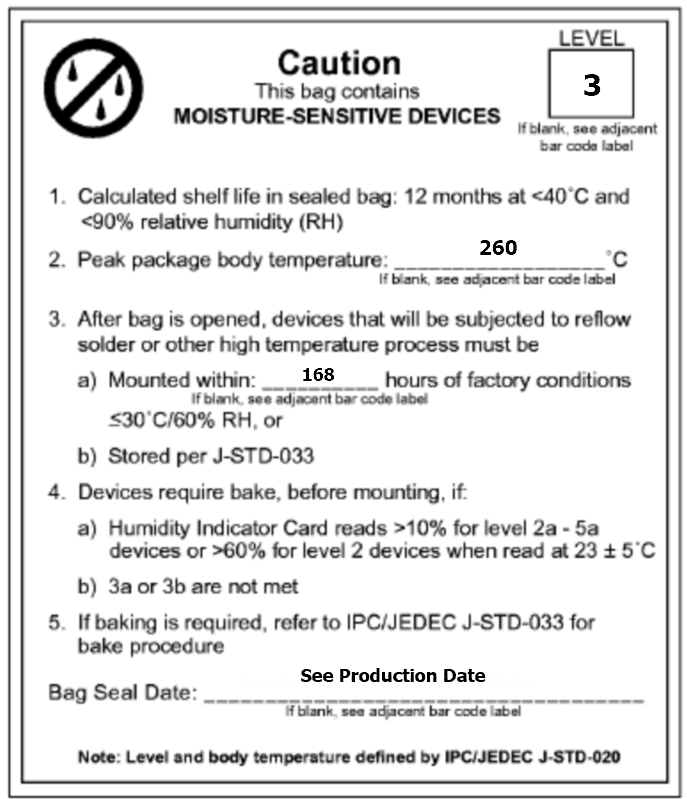
MOQ and packaging information
| Product model | MOQ (pcs) | Shipping packaging | Modules per reel | Reels per carton |
|---|---|---|---|---|
| T3-U | 4,400 | Tape and reel | 1,100 | 4 |
Appendix: Statement
FCC Caution: Any changes or modifications not expressly approved by the party responsible for compliance could void the user’s authority to operate this device.
This device complies with Part 15 of the FCC Rules. Operation is subject to the following two conditions: (1) This device may not cause harmful interference, and (2) this device must accept any interference received, including interference that may cause undesired operation.
List of applicable FCC rules
This module has been granted modular approval as below listed FCC rule parts.
-FCC Rule parts 15C (15.247)
List of applicable ISED rules
This module has been certificated modular approval as below listed ISED Radio Standards Specifications.
-RSS 247 Issue 3
This device generates, uses, and can radiate radio frequency energy and, if not installed and used following the instructions, may cause harmful interference to radio communications. However, there is no guarantee that interference will not occur in a particular installation. If this device does cause harmful interference to radio or television reception, which can be determined by turning the device off and on, the user is encouraged to try to correct the interference by one or more of the following measures:
• Reorient or relocate the receiving antenna.
• Increase the separation between the device and receiver.
• Connect the device to an outlet on a circuit different from that to which the
receiver is connected.
• Consult the dealer or an experienced radio/TV technician for help.
Radiation Exposure Statement
This device complies with FCC radiation exposure limits set forth for an uncontrolled rolled environment. This device should be installed and operated with a minimum distance of 20cm between the radiator and your body.
Important Note
This radio module must not be installed to co-locate and operate simultaneously with other radios in the host system except by following FCC multi-transmitter product procedures. Additional testing and device authorization may be required to operate simultaneously with other radios.
The availability of some specific channels and/or operational frequency bands are country dependent and are firmware programmed at the factory to match the intended destination. The firmware setting is not accessible to the end-user.
The host product manufacturer is responsible for compliance with any other FCC rules that apply to the host not covered by the modular transmitter grant of certification. The final host product still requires Part 15 Subpart B compliance testing with the modular transmitter installed. The separate approval is required for all other operating configurations including portable configurations with respect to Part 2.1093 and different antenna configurations.
The end-user manual shall include all required regulatory information/warnings as shown in this manual, including “This product must be installed and operated with a minimum distance of 20 cm between the radiator and user body”. The OEM integrator is responsible for ensuring that the end-user has no manual instructions to remove or install the module.
This device has got an FCC ID: 2ANDL-T3-U. The end product must be labeled in a visible area with the following: “Contains Transmitter Module FCC ID: 2ANDL-T3-U”.
This device is intended only for OEM integrators under the following conditions:
The antenna must be installed such that 20cm is maintained between the antenna and users, and the transmitter module may not be co-located with any other transmitter or antenna.
As long as the 2 conditions above are met, further transmitter tests will not be required. However, the OEM integrator is still responsible for testing their end-product for any additional compliance requirements required with this module installed.
Declaration of Conformity European Notice

Hereby, Hangzhou Tuya Information Technology Co., Ltd declares that this module product is in compliance with essential requirements and other relevant provisions of Directive 2014/53/EU,2011/65/EU. A copy of the Declaration of Conformity can be found at https://www.tuya.com.

This product must not be disposed of as normal household waste, in accordance with the EU directive for waste electrical and electronic equipment (WEEE-2012/19/EU). Instead, it should be disposed of by returning it to the point of sale, or to a municipal recycling collection point.
The device could be used with a separation distance of 20cm from the human body.
Industry Canada Statement
This device complies with Industry Canada’s licence-exempt RSSs. Operation is subject to the following two conditions:
(1) This device may not cause interference.
(2) This device must accept any interference, including interference that may cause undesired operation of the device.
Le présent appareil est conforme aux CNR d’Industrie Canada applicables aux appareils radio exempts de licence. L’exploitation est autorisée aux deux conditions suivantes:
(1) l’appareil ne doit pas produire de brouillage.
(2) l’utilisateur de l’appareil doit accepter tout brouillage radioélectrique sub i, même si le brouillage est susceptible d’en compromettre le fonctionnement.
Radiation Exposure Statement
This equipment complies with IC radiation exposure limits set forth for an uncontrolled environment. This equipment should be installed and operated with minimum distance 20 cm between the radiator & your body.
Déclaration d’exposition aux radiations:
Cet équipement est conforme aux limites d’exposition aux rayonnements ISED établies pour un environnement non contrôlé. Cet équipement doit être installé et utilisé avec un minimum de 20 cm de distance entre la source de rayonnement et votre corps.
L’appareil peut interrompre automatiquement la transmission en cas d’absence d’informations à transmettre ou de panne opé rationnelle. Notez que ceci n’est pas destiné à interdire la transmission d’informations de contrôle ou de signalisation ou l’utilisation de codes répétitifs lorsque cela est requis par la technologie.
This device is intended only for OEM integrators under the following conditions:
(1) The antenna must be installed such that 20 cm is maintained between the antenna and users.
(2) The transmitter module may not be co-located with any other transmitter or antenna. As long as 2 conditions above are met, further transmitter test will not be required.
However, the OEM integrator is still responsible for testing their end-product for any additional compliance requirements required with this module installed.
Cet appareil est conçu uniquement pour les intégrateurs OEM dans les conditions
suivantes: (Pour utilisation de dispositif module)
(1) L’antenne doit être installée de telle sorte qu’une distance de 20 cm est respectée entre l’antenne et les utilisateurs.
(2) Le module émetteur peut ne pas être coïmplanté avec un autre é metteur ou antenne.
Tant que les 2 conditions ci-dessus sont remplies, des essais supplé mentaires sur l’émetteur neseront pas nécessaires. Toutefois, l’intégrateur OEM est toujours responsable des essais sur son produit final pour toutes exigences de conformité supplémentaires requis pour ce module installé.
IMPORTANT NOTE:
In the event that these conditions can not be met (for example certain laptop configurations or colocation with another transmitter), then the Canada authorization is no longer considered valid and the IC ID can not be used on the final product. In these circumstances, the OEM integrator will be responsible for re-evaluating the end product (including the transmitter) and obtaining a separate Canada authorization.
NOTE IMPORTANTE:
Dans le cas où ces conditions ne peuvent être satisfaites (par exemple pour certaines configurations d’ordinateur portable ou de certaines co-localisation avec un autre émetteur), l’autorisation du Canada n’est plus considéré comme valide et l’ID IC ne peut pas être utilisé sur le produit final. Dans ces circonstances, l’intégrateur OEM sera chargé de réévaluer le produit final (y compris l’émetteur) et l’obtention d’une autorisation distincte au Canada.
End Product Labeling
This transmitter module is authorized only for use in device where the antenna may be installed such that 20 cm may be maintained between the antenna and users. The final end product must be labeled in a visible area with the following: “Contains IC:23243-T3U” .
Plaque signalétique du produit final
Ce module émetteur est autorisé uniquement pour une utilisation dans un dispositif où l’antenne peut être installée de telle sorte qu’une distance de 20cm peut être maintenue entre l’antenne et les utilisateurs. Le produit final doit être étiqueté dans un endroit visible avec l’inscription suivante: “Contient des IC:23243-T3U”.
Manual Information To the End User
The OEM integrator has to be aware not to provide information to the end user regarding how to install or remove this RF module in the user’s manual of the end product which integrates this module.
The end user manual shall include all required regulatory information/warning as show in this manual.
Manuel d’information à l’utilisateur final
L’intégrateur OEM doit être conscient de ne pas fournir des informations à l’utilisateur final quant à la façon d’installer ou de supprimer ce module RF dans le manuel de l’utilisateur du produit final qui intègre ce module.
Le manuel de l’utilisateur final doit inclure toutes les informations réglementaires requises et avertissements comme indiqué dans ce manuel.
Is this page helpful?
YesFeedbackIs this page helpful?
YesFeedback





